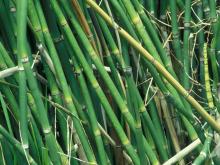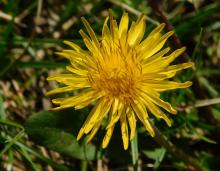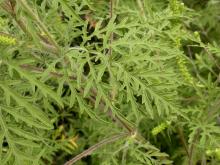Wildflowers, Grasses and Other Nonwoody Plants
Media

Species Types
Scientific Name
Equisetum (3 spp. in Missouri)
Description
Horsetails, or scouring rushes, are in the genus Equisetum. They’re easy to recognize with their jointed, hollow stems. Like ferns, they reproduce via spores instead of flowers and seeds.
Media

Species Types
Scientific Name
Onoclea sensibilis
Description
The leaves of sensitive fern usually wither quickly upon the first frost, leaving the upright, beadlike, spore-bearing spikes to be noticeable.
Media

Species Types
Scientific Name
Asplenium rhizophyllum (syn. Camptosorus rhyzophyllus)
Description
One of Missouri’s most distinctive ferns, walking fern walks. Its long, triangular leaves take root at the elongated tips, forming new plantlets.
Media

Species Types
Scientific Name
Phegopteris hexagonoptera
Description
Broad beech fern has broadly triangular leaves that tilt backward from their long, upright stalks. Wings of leafy tissue connect the main leaf lobes along the main axis, and the bottommost lobes usually point downward.
Media

Species Types
Scientific Name
Taraxacum officinale
Description
The common dandelion is a well-known common weed of lawns, roadsides, and other disturbed places. Originally from Europe, it occurs nearly worldwide.
Media

Species Types
Scientific Name
Sagittaria spp.
Description
Arrowheads are aquatic plants with erect, usually arrow-shaped leaves and distinctive three-petaled flowers. They are often called duck potatoes because ducks, geese, and swans relish the tuberlike rootstocks.
Media

Species Types
Scientific Name
Chenopodium album
Description
Lamb’s quarters won’t win any beauty contests for its flowers, but it merits an award for being both a common garden weed as well as a nutritious leafy green valued around the world.
Media

Species Types
Scientific Name
Viola viarum
Description
The leaf blades of plains, or wayside violet are highly variable, and the plant produces differently shaped leaves as the season progresses. It’s quite similar to cleft violet, but the leaves are smooth and hairless.
Media

Species Types
Scientific Name
Helenium virginicum
Description
Virginia sneezeweed is the rarest of Missouri’s four sneezeweeds. A state endangered and federally threatened species, it occurs in about 60 sites in our southern Ozark counties, primarily in boggy, sinkhole pond habitats.
Media

Species Types
Scientific Name
Ambrosia artemisiifolia
Description
Common ragweed is instantly recognizable by its ornate, 2–3 times pinnately lobed, hairy leaves. You’ve probably seen it many times and wondered what it was.
See Also
About Wildflowers, Grasses and Other Nonwoody Plants in Missouri
A very simple way of thinking about the green world is to divide the vascular plants into two groups: woody and nonwoody (or herbaceous). But this is an artificial division; many plant families include some species that are woody and some that are not. The diversity of nonwoody vascular plants is staggering! Think of all the ferns, grasses, sedges, lilies, peas, sunflowers, nightshades, milkweeds, mustards, mints, and mallows — weeds and wildflowers — and many more!





















